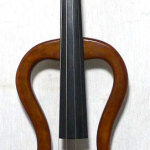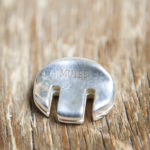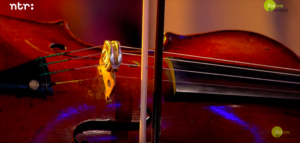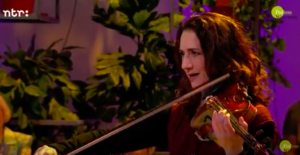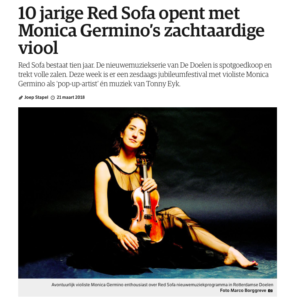Decibels & Instruments & Mutes: the backstory
The specialists were unanimous: my ears are highly sensitive to sound. ‘Geluidsgevoelig,’ in Dutch. It sounded almost positive to me, ‘sensitive to sound.’ It’s also not uncommon. But a high sensitivity to sound means that my ears are more prone to damage. A person standing next to me could be exposed to exactly the same sounds, yet not be affected. The advice was clear: to protect my hearing by significantly reducing my exposure to high decibel (dB) levels.
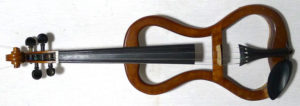

pictured here: the frame violin, also known as a mute violin, ca. 1870. It has a beautiful, intimate, overtone-rich sound. Surprisingly little is known about these striking instruments. One resource is the National Music Museum at the University of South Dakota, whose collection houses what could be this frame violin’s sister…
MUTED
Cue the new music community: resourceful, supportive and stubborn composers and colleagues who lifted me up and pulled me along this fascinating journey. Ups and downs and the unexpected began to feel like the status quo. Michael Gordon‘s response to what was drastic news to me —having to protect my hearing by stopping or adapting how I played the violin — was one of optimism and curiosity. I’ll never forget his words: “I’m going to write you a piece so soft, I don’t care if no one can hear it.” Michael, David Lang, and Julia Wolfe decided to join forces to create MUTED, “the quietest violin piece ever written.” The three later invited Louis Andriessen to join in the experiment, fulfilling a long-held wish to collaborate.
Watch musical excerpt by Louis Andriessen here (Podium Witteman, live television broadcast)
Special thanks to luthier Bas Maas and designer Marcel Wanders, who are creating an entirely new, lower-decibel instrument, a ‘whisperviolin,’ inspired by and loosely modeled on the 17th-century ‘pochette’ violin, but created to explore the world of quieter sounds. Besides unmatched creativity and unparalleled skill, both bring a sense of adventure and a palpable excitement to the process.
It’s new territory for me, there’s an uncharted development process ahead, and a completely new sound world to figure out. My work has always been composer driven, and I am extremely grateful to and moved by the active role composers and colleagues are taking in this enforced, bewildering, and somehow increasingly exciting development in my creative path as a musician.
Watch live TV broadcast of Podium Witteman here -the segment about MUTED starts at 6’55” (in Dutch). Music: 19’30”
“The American-Dutch violinist Monica Germino, known for her electronically amplified performances of music by contemporary composers, is given the worst conceivable news three years ago: she has to stop making music or take drastic measures to protect her hearing.” …READ MORE
“…As the pop-up artist, Monica Germino will decide what she will actually play in the moment. It will certainly be soft, because a few years ago Germino was diagnosed as ‘sensitive to sound,’ which means that her ears are more prone to damage [from high decibel levels]. She had to say goodbye to the high-octane soundtracks and louder works for electric violin, giving up many pieces she had often performed.
She is now “more curious than sad,” says Germino. Playing quietly opens up a whole new dimension; and apart from a reflection on silence and listening it can also be “an antidote to the relentless noise of our world.” She has amassed a huge collection of mutes (sourdines) and plays a rare ‘frame violin’ from ca. 1870, an instrument without a sound box which therefore plays at a very low volume. Germino: “Neil [Wallace] wants me to play the frame violin in the Main Hall without any amplification; for me that’s a thrill, an adventure.” Wallace: “You will hear a pin drop.”
Spring Loaded Festival: 10 years of Red Sofa. De Doelen Rotterdam. www.dedoelen.nl
The mutes in MUTED
Central to Monica Germino’s work is her unusual family of instruments, as well as her ever-expanding collection of mutes. Germino’s ongoing search has resulted in over 400 vintage, modern, and newly commissioned mutes. A mute (a.k.a. sourdine, sordino, demper) can alter the sound of the violin in countless ways. From Canada to Spain, mute-makers are experimenting with new designs and all kinds of materials – leather, metal, cork, magnets, plexiglass, bone, rubber, paper, textiles, the list goes on.

The instruments
- A (muted) J. B. Ceruti violin from Cremona (1802) on permanent loan from the Elise Mathilde Foundation
- Two rare frame violins, also known as mute violins, with a delicate, surprisingly overtone-rich sound (ca. 1870 and 1970)
- A custom-made Violectra electric violin (2007)
- The new whisperviolin (2018), by Bas Maas and Marcel Wanders
- A ‘whisperbow,’ made of carbon fibre, produces a wispy, delicate sound
The whisperviolin (2018) (in progress)
To add to the instrumentarium, luthier Bas Maas and designer Marcel Wanders are creating an entirely new, lower-decibel instrument, a ‘whisperviolin,’ inspired by and loosely modeled on the 17th-century ‘pochette’ violin. This instrument is being created to explore the world of quieter sounds. When Wanders took on this challenge, he spoke about decibels and sound and his fascination with “designing a violin for Monica, and how this could ultimately also help other violinists.” Marcel Wanders played the violin for 6 years and reveres its history, shape, and form. Bas Maas is on a quest for ways that unconventional ideas could possibly work. Besides unmatched creativity and unparalleled skill, both bring a sense of adventure and a palpable excitement to the process.
Marcel Wanders: “The hope also is that this new instrument will end up helping other violinists as well. Monica is not the only one going through this.”
I wholeheartedly agree. As interesting as this whole journey is, I hope going down this path can help other musicians. On that note…
MUTED premiered on 7 – 8 – 9 June 2018 at the Oranjewoud Festival, Museum Belvedere.
A collective work by 4 composers for violin, voice, whisperviolin, frame violins, a multitude of mutes, and light
Composers: Louis Andriessen, Michael Gordon, David Lang, Julia Wolfe
Stage design & lighting: Floriaan Ganzevoort
Watch broadcast of Podium Witteman here -the segment about MUTED starts at 6’55” (in Dutch). Music: 19’30”
Excerpt by Louis Andriessen here
**Text: excerpts from Archy and Mehitabel by Don Marquis
*Cast of credits, MUTED:
Oranjewoud Festival, Oranjewoud
Music on Main, Vancouver
Huddersfield Contemporary Music Festival
Partners and presenters
Wonderfeel Festival
Korzo, Den Haag
Muziekgebouw aan ‘t IJ, Amsterdam
November Music, Den Bosch
With thanks to
Michael Gordon, Julia Wolfe, David Lang, Louis Andriessen
MassMoCA, Massachusetts, USA
Kenny Savelson, Bang on a Can All-Stars
Phillipa Thompson, Bang on a Can Summer Festival
Vera Kuiper, Dutch Consulate, New York
Neil Wallace, Programme Director, de Doelen
Bas Maas, luthier
Marcel Wanders, designer
Niek Versfeld and Jaap Peter Kronemeijer, Audiologisch Centrum Hilversum
Stijn Hoogeboom, Oorwerk, Hilversum
Jacqueline & Serge Stam, Stam Vioolbouw
photos Anne Reinke

